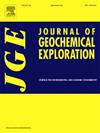东天山中宝钨矿早二叠世花岗质岩浆作用与成矿作用:地质年代学和全岩地球化学约束
IF 3.3
2区 地球科学
Q1 GEOCHEMISTRY & GEOPHYSICS
引用次数: 0
摘要
在东天山中天山地体西南部,发现了大量与花岗质地层有关的早二叠世钨矿床。然而,花岗岩岩浆、成矿作用和构造环境之间的关系仍存在争议。中堡W矿床在空间上与库米什地区的云母二长花岗岩伴生。花岗岩的锆石和独居石UPb定年结果为304 ~ 298 Ma,与灰色矿体内白云母的40Ar/39Ar年龄(296 Ma)一致,表明中堡岩体与W矿化存在成因联系。地球化学特征表明,花岗岩为高分选i型,SiO2、K2O含量高,Na2O/K2O含量低,微量元素特征明显(宽10000 *Ga/Al = 2.24 ~ 2.99, Zr + Nb + Ce + Y <;P2O5与SiO2呈负相关。同位素数据(εNd(t) = - 6.77 ~ - 3.15;εHf(t) = - 0.9 ~ +3.3;(207Pb/204Pb)i = 15.581 ~ 15.714;δ18OV-SMOW = 7.61 ~ 14.17‰),表明古地壳源。较低的锆石Ce4+/Ce3+(9.8 ~ 164)和δEu(0.10 ~ 0.57)比值表明较低的氧逸度,而较低的K/Rb和较高的Rb/Sr比值表明有明显的分离结晶作用,对成矿元素的输运和富集至关重要。中宝岩体的i型花岗岩特征表明其形成于后碰撞构造环境。早二叠世以中宝钨矿床为代表,在中天山地体与塔里木克拉通之间形成了一条北西向成矿带。此外,确定了早二叠世中天山地体西南缘的碰撞后伸展环境。本文认为中宝W矿床的形成与早二叠世南天山洋局部闭合有关。本文章由计算机程序翻译,如有差异,请以英文原文为准。
Early Permian granitic magmatism and mineralization in the Zhongbao W deposit, East Tianshan, NW China: Constraints from geochronology and whole-rock geochemistry
Numerous Early Permian tungsten (W) deposits, associated with granitic formations, have been identified in the southwest of the Central Tianshan terrane, East Tianshan, NW China. However, the relationship between granitic magma, mineralization, and tectonic setting remains debated. The Zhongbao W deposit is spatially associated with mica monzogranite in the Kumish area. Zircon and monazite U![]() Pb dating of the granite yielded ages of 304–298 Ma, consistent with the 40Ar/39Ar age of 296 Ma from muscovite within the greisen orebodies, indicating a genetic link between the Zhongbao pluton and W mineralization. Geochemically, the granite is highly fractionated I-type, with high SiO2 and K2O, low Na2O/K2O, and distinct trace element characteristics (e.g., wide 10,000*Ga/Al = 2.24–2.99, Zr + Nb + Ce + Y < 350 ppm), with a negative correlation exists between P2O5 and SiO2. Isotopic data (εNd(t) = −6.77 to −3.15; εHf(t) = −0.9 to +3.3; (207Pb/204Pb)i = 15.581 to 15.714; δ18OV-SMOW = 7.61 to 14.17 ‰) suggest an ancient crustal source. Low zircon Ce4+/Ce3+ (9.8–164) and δEu (0.10–0.57) ratios imply low oxygen fugacity, while low K/Rb and high Rb/Sr ratios indicate significant fractional crystallization, crucial for transportation and concentration of ore-forming elements. The I-type granite characteristics of the Zhongbao pluton suggest its formation during a post-collisional tectonic setting. Furthermore, the Early Permian W deposits, including Zhongbao W deposit, constitute a NW-trending mineralization belt situated between the Central Tianshan terrane and the Tarim Craton. Additionally, the post-collisional extension setting has been identified along the southwestern margin of the Central Tianshan terrane during the Early Permian. We propose that the formation of Zhongbao W deposit be attributed to the local closure of the southern Tianshan ocean in the Early Permian.
Pb dating of the granite yielded ages of 304–298 Ma, consistent with the 40Ar/39Ar age of 296 Ma from muscovite within the greisen orebodies, indicating a genetic link between the Zhongbao pluton and W mineralization. Geochemically, the granite is highly fractionated I-type, with high SiO2 and K2O, low Na2O/K2O, and distinct trace element characteristics (e.g., wide 10,000*Ga/Al = 2.24–2.99, Zr + Nb + Ce + Y < 350 ppm), with a negative correlation exists between P2O5 and SiO2. Isotopic data (εNd(t) = −6.77 to −3.15; εHf(t) = −0.9 to +3.3; (207Pb/204Pb)i = 15.581 to 15.714; δ18OV-SMOW = 7.61 to 14.17 ‰) suggest an ancient crustal source. Low zircon Ce4+/Ce3+ (9.8–164) and δEu (0.10–0.57) ratios imply low oxygen fugacity, while low K/Rb and high Rb/Sr ratios indicate significant fractional crystallization, crucial for transportation and concentration of ore-forming elements. The I-type granite characteristics of the Zhongbao pluton suggest its formation during a post-collisional tectonic setting. Furthermore, the Early Permian W deposits, including Zhongbao W deposit, constitute a NW-trending mineralization belt situated between the Central Tianshan terrane and the Tarim Craton. Additionally, the post-collisional extension setting has been identified along the southwestern margin of the Central Tianshan terrane during the Early Permian. We propose that the formation of Zhongbao W deposit be attributed to the local closure of the southern Tianshan ocean in the Early Permian.
求助全文
通过发布文献求助,成功后即可免费获取论文全文。
去求助
来源期刊

Journal of Geochemical Exploration
地学-地球化学与地球物理
CiteScore
7.40
自引率
7.70%
发文量
148
审稿时长
8.1 months
期刊介绍:
Journal of Geochemical Exploration is mostly dedicated to publication of original studies in exploration and environmental geochemistry and related topics.
Contributions considered of prevalent interest for the journal include researches based on the application of innovative methods to:
define the genesis and the evolution of mineral deposits including transfer of elements in large-scale mineralized areas.
analyze complex systems at the boundaries between bio-geochemistry, metal transport and mineral accumulation.
evaluate effects of historical mining activities on the surface environment.
trace pollutant sources and define their fate and transport models in the near-surface and surface environments involving solid, fluid and aerial matrices.
assess and quantify natural and technogenic radioactivity in the environment.
determine geochemical anomalies and set baseline reference values using compositional data analysis, multivariate statistics and geo-spatial analysis.
assess the impacts of anthropogenic contamination on ecosystems and human health at local and regional scale to prioritize and classify risks through deterministic and stochastic approaches.
Papers dedicated to the presentation of newly developed methods in analytical geochemistry to be applied in the field or in laboratory are also within the topics of interest for the journal.
 求助内容:
求助内容: 应助结果提醒方式:
应助结果提醒方式:


